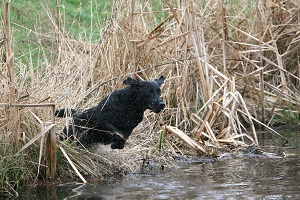Sporting enthusiasts know injuries hinder a dog’s performance in the field. Broken bones and torn ligaments are ailments veterinarians and some dog owners easily can diagnose. Subtle injuries, such as sore wrists, swollen joints and aching backs, are less obvious, but they, too, can impact a dog’s performance.
These subtle injuries don't show up on X-rays and, thus, can be undiagnosed or misdiagnosed. Robert Gillette, D.V.M., M.S., director of the Auburn University Veterinary Sports Medicine Program, has done extensive research with hunting dogs. He has seen the significance of soft-tissue injuries that do not show up on X-rays but can make the difference between winning and losing in field trials.
"There are quite a few soft-tissue problems in athletic dogs that are not identified," says Gillette, "but three big injury points we have determined are the wrists, back muscles and sesamoid bones, which are embedded within tendons that pass over joints.”
Gillette studied 54 dogs to gauge their musculoskeletal injuries prior to the start of their athletic season. Golden Retrievers, Labrador Retrievers, English Springer Spaniels, Curly Coated Retrievers and American Cocker Spaniels were included.
The dogs tested were not lame and were not obviously ailing, yet many had nagging aches and pains with the potential to impact performance. "When you get to the elite level of competition with dogs,” Gillette says, “little things make a difference. For example, a Pointer distracted by pain is likely to cover less ground, make fewer finds and have trouble being steady, compared to one that runs big and is stylish to win.”
The study pinpointed minor injuries that dog owners and veterinarians can look for when diagnosing problems. These included injuries to wrists, chest and stomach quadrants, and rearlimb and forelimb sesamoids (small bones that form the knuckles).

This is important data, Gillette says, because these injuries don’t show up on X-rays. There are no fractures involved. "They are just everyday tweaks that would have no effect on a pet dog but surface in elite canine athletes,” he says.
Dog owners should be cautious of behaviors in their dogs that could indicate pain. "If something doesn't seem quite right in a dog’s movement, it probably isn't," Gillette says. "Sometimes when you go to your vet, the dog is stoic and won't exhibit signs. It helps if you can say, 'Check the wrist, check the sesamoids, check the back muscles."
One of the study's more intuitive findings was that dogs are more prone to injuries after 3 years of age. While there's no way to slow aging, Gillette says being aware of minor injuries can help keep those ailments from becoming major.
"Now that we've identified some underlying problems, if we address them early they won't be bigger issues once the dog gets older," Gillette says. "Otherwise what we see is a cumulative effect. One thing leads to another. If we can identify the primary problems early, we can stop the secondary problems."
Gillette’s research findings also suggest there is not a significant difference in injuries faced by dogs that train all year versus dogs that had an off-season. Owners who compete with their athletic dogs are helping their dogs to stay fit while allowing them to pursue their natural desires.